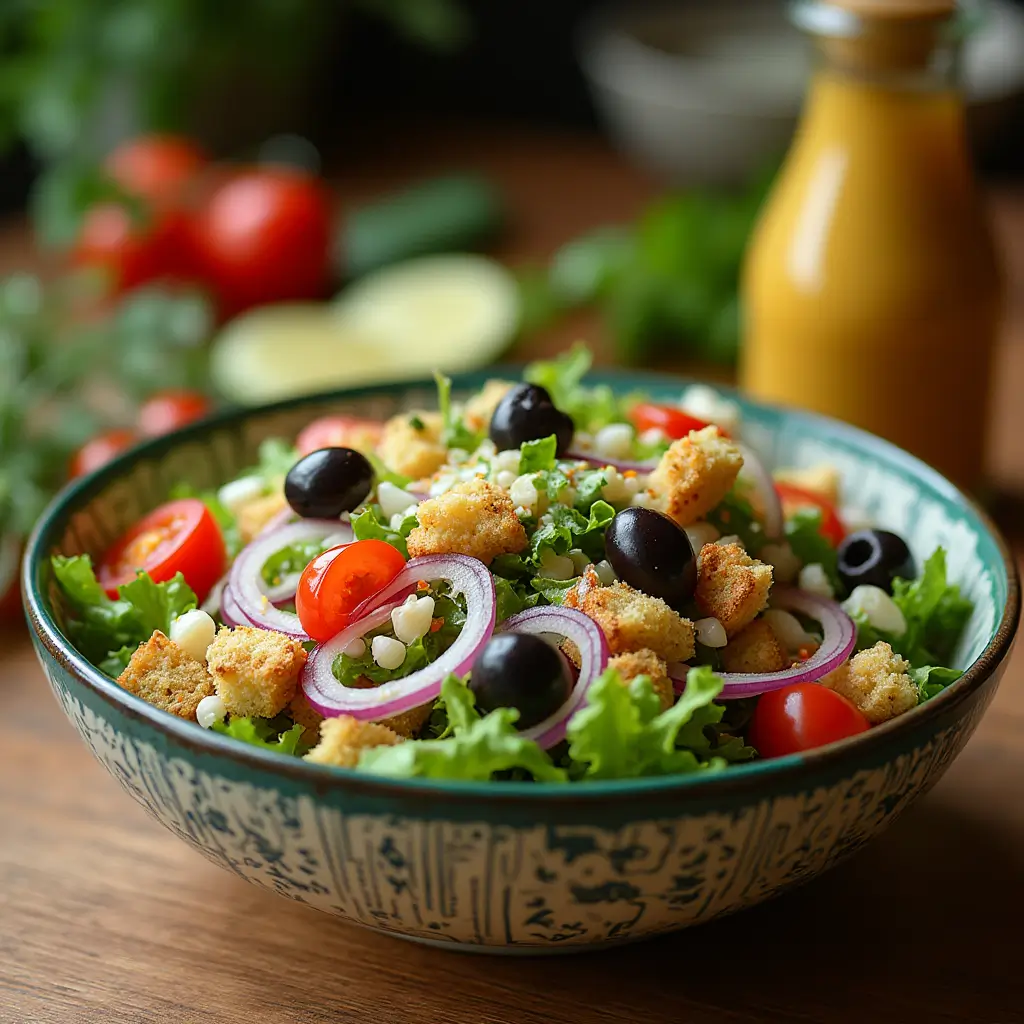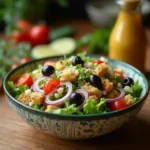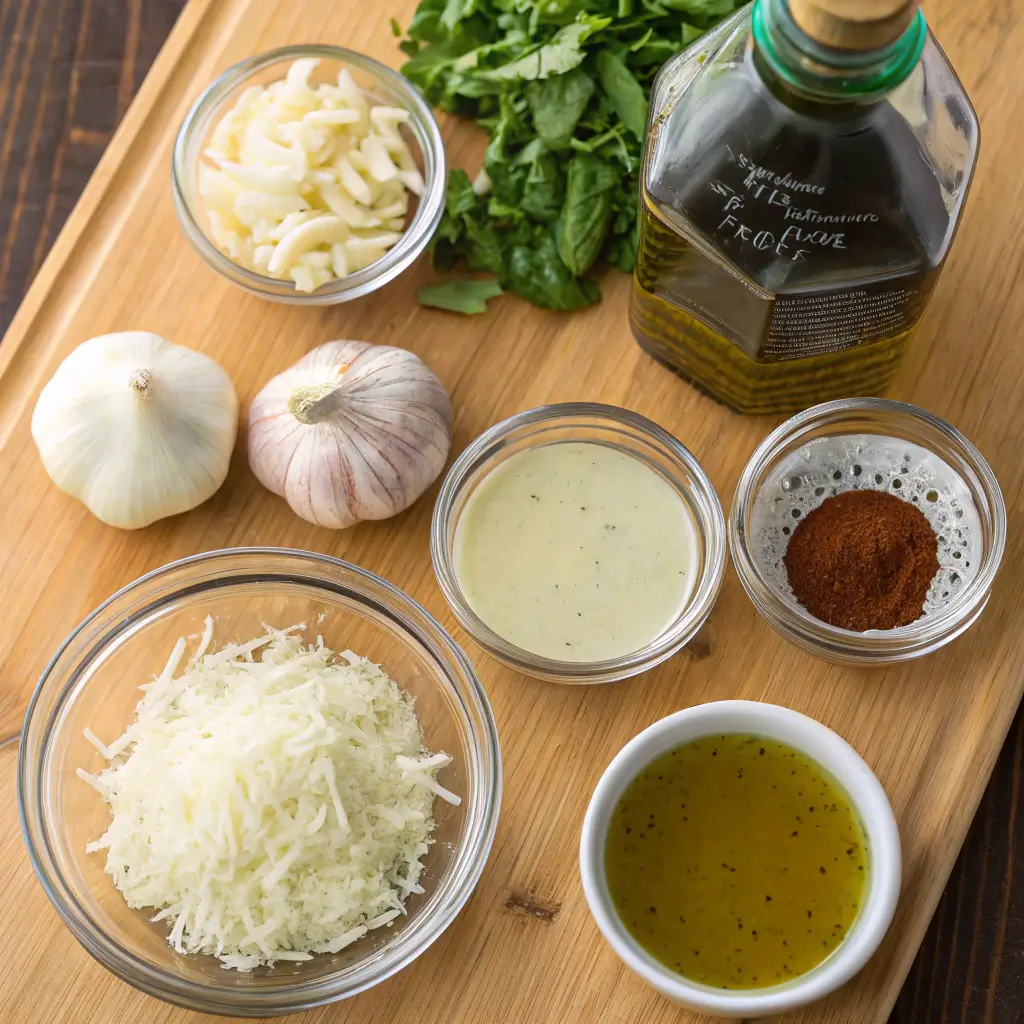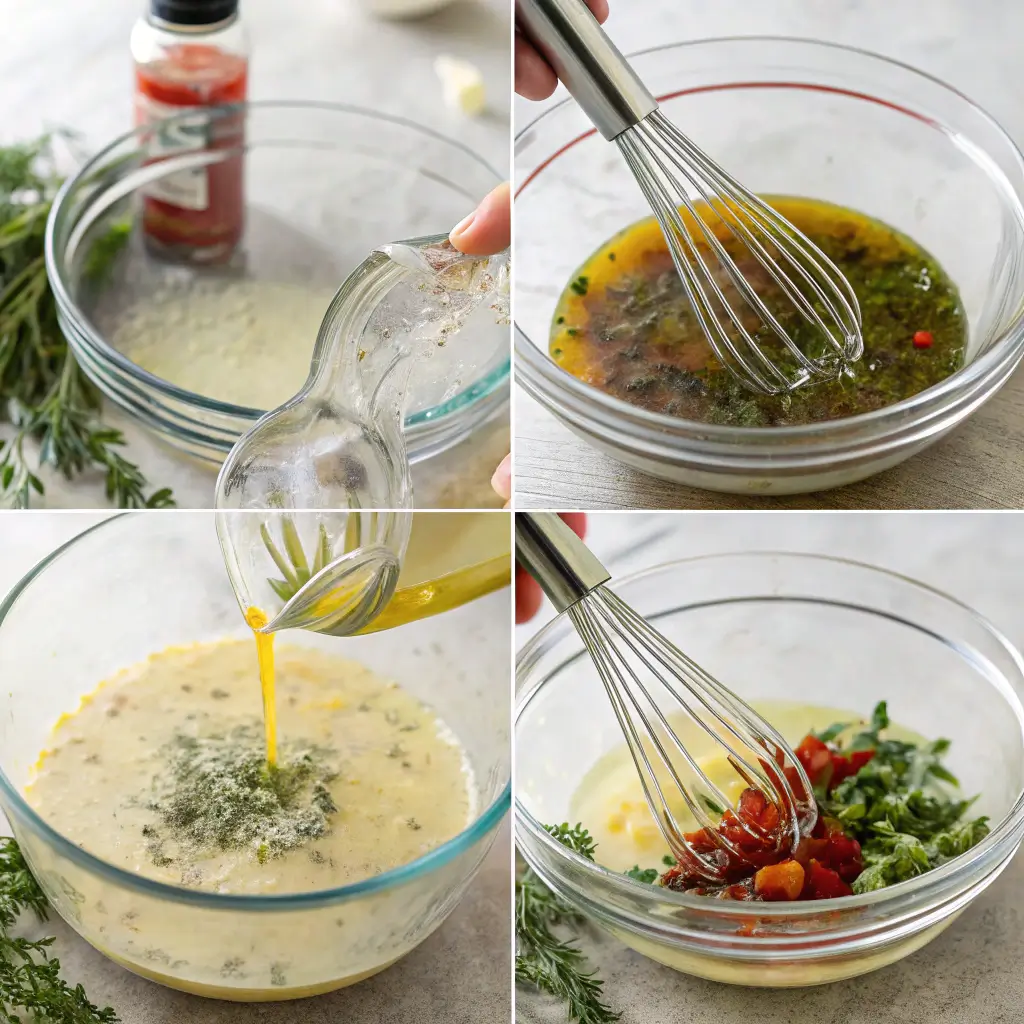Olive Garden salad dressing has become a cult favorite across the United States, and for good reason. This zesty, slightly creamy Italian-style dressing adds a flavorful punch to any salad—and it’s not just limited to restaurant tables. Whether you’re a health-conscious eater asking, “Is Olive Garden salad dressing gluten-free?” or a home cook eager to make a spot-on copycat version, this article breaks it all down. You’ll find ingredients, recipes, nutrition info, and even where to buy it.

Looking for inspiration? Try our take on the Irresistible Olive Oil Bread Dip to pair with your Olive Garden-style meal.
Print
Olive Garden Salad Dressing
- Total Time: 5 minutes
- Yield: 10
Description
This Olive Garden Salad Dressing copycat recipe brings the restaurant’s signature zesty, creamy flavor right to your kitchen. This tangy dressing has simple ingredients and easy steps for the perfect homemade version any day!
Ingredients
- 1 cup Olive Oil
- ½ cup Mayonnaise
- 2 tablespoons Dijon Mustard
- ¼ cup Parmesan Cheese grated
- 3 tbsps Vinegar
- 1 teaspoon Garlic Powder
- ½ teaspoon Onion Powder
- 1 teaspoon Herbes de Provence
- 1 teaspoon Italian Seasoning
- 1 teaspoon Sugar
- Salt & Pepper to taste
Instructions
- whisk together the ingredients – olive oil, mayonnaise, Dijon mustard, Parmesan cheese, red wine vinegar, garlic powder, onion powder, Herbes de Provence, Italian seasoning, sugar, salt and pepper – in a bowl. Whisk everything together until smooth and combined.
- Blend to Smooth – Transfer the mix into a blender and blend on low for 10-15 seconds. This will keep the dressing nice and silky and well emulsified.
- Taste & Adjust – Taste the dressing and season to your preference — add more salt, pepper or vinegar as desired. Briefly blend again to mix in any changes.
- Chill & Serve – Transfer the dressing to a jar or bottle, cover and refrigerate until ready to serve (at least 30 minutes) to let the flavors meld. Drizzle atop your favorite salad or use as a dip!
- Prep Time: 5 minutes
- Category: Brunch, condiments, dip, Dressing
- Cuisine: American, Italian
Nutrition
- Calories: 2833kcal
- Sugar: 6g
- Sodium: 1451mg
- Fat: 307g
- Saturated Fat: 47g
- Trans Fat: 0.2g
- Carbohydrates: 12g
- Fiber: 3g
- Protein: 12g
- Cholesterol: 64mg
Keywords: Italian Dressing, Salad Dressing
Let’s dig into why this dressing continues to win over salad lovers nationwide.
PART 1: The Popularity Behind Olive Garden Salad Dressing
Why Olive Garden Salad Dressing is So Loved
Olive Garden’s salad dressing isn’t just an appetizer—it’s a core part of the brand experience. With its balanced mix of tangy vinegar, sharp Romano cheese, savory herbs, and a touch of sweetness, it hits every flavor note. The combination is designed to please a wide audience, pairing perfectly with their endless salad bowl and fluffy breadsticks.
Table of Contents
People crave it because it’s nostalgic and dependable. That bold Italian flavor stirs memories of family dinners, casual date nights, and celebratory lunches. It’s comforting, familiar, and full of flavor.
From Restaurant to Home: The Dressing’s Influence on American Dining
What began as a restaurant-exclusive dressing quickly spilled into grocery aisles and home kitchens. Olive Garden fans demanded more, and the company responded by bottling the same signature taste for retail. Now, you can find it at places like Walmart, Target, and Amazon.
This home adaptation of restaurant favorites reflects a larger trend in American dining—bringing the restaurant experience into everyday meals. Olive Garden salad dressing has also inspired hundreds of online copycat recipes, signaling just how deeply embedded it is in modern food culture.
Check out our twist on zesty salads like this Ranch Pasta Salad using Olive Garden dressing as a base for unique flavor.
PART 2: What Is Olive Garden Salad Dressing Made Of?
Key Ingredients and Their Role
If you’ve ever tasted Olive Garden salad dressing, you know it’s not your average Italian blend. It’s richer, zestier, and bursting with that classic flavor everyone craves. The secret lies in the balanced combination of ingredients that give Olive Garden salad dressing its creamy, tangy punch.

Here’s a breakdown of the essential components in both the restaurant and bottled versions:
| Ingredient | Purpose in Dressing |
|---|---|
| Acts as the foundation | delivering a silky-smooth consistency. |
| Vinegar (White/Red) | Adds acidity and sharpness |
| Romano Cheese | Delivers salty, umami depth |
| Sugar | Balances acidity with a touch of sweetness |
| Garlic and Onion | Brings aromatic and savory layers |
| Lemon Juice Concentrate | Lends brightness and a citrus twist |
| Salt & Spices | Enhances overall flavor |
| Xanthan Gum | Thickens and stabilizes the dressing |
Each ingredient plays a vital role in what makes Olive Garden salad dressing so iconic and crave-worthy.
Comparing Store-Bought vs Restaurant Version
Wondering if the bottled version of Olive Garden salad dressing measures up to what’s served in-house? You’re not alone. While the store-bought bottle comes close, it’s not a perfect replica of the restaurant’s original.
Flavor Profile Comparison:
| Feature | Restaurant Version | Store-Bought Version |
|---|---|---|
| Freshness Level | Fresher, with bold herbaceous flavors | Milder, with longer shelf stability |
| Cheese Content | Strong Romano cheese flavor | Slightly toned-down cheese taste |
| Texture | Creamy and well-emulsified | Thinner and less rich |
| Sodium Content | Moderate saltiness | Higher sodium for preservation |
While the core of Olive Garden salad dressing remains intact across versions, the bottled product uses stabilizers and preservatives that slightly shift the flavor profile. That said, it’s still one of the best off-the-shelf Italian dressings you can find today.
PART 3: Is Olive Garden Salad Dressing Gluten-Free?
Understanding Gluten-Free Labels on Olive Garden Products
If you’re gluten-sensitive or diagnosed with celiac disease, one of the first questions that comes to mind is: Is Olive Garden salad dressing gluten-free? According to Olive Garden’s official allergen guide, the signature salad dressing does not contain gluten-containing ingredients. However, there’s a crucial difference between being made without gluten and being certified gluten-free.
Let’s break this down:
- Restaurant Version: Olive Garden states that their salad dressing is prepared without gluten, but cross-contamination may occur due to shared kitchen equipment. If you have celiac disease, it’s best to ask your server to skip the croutons and verify prep practices.
- Store-Bought Version: Bottled Olive Garden salad dressing is labeled gluten-free on most retail packages. These are manufactured under stricter conditions to meet gluten-free standards, making them safer for home use.
For peace of mind, always double-check the label and allergen info provided on Olive Garden’s official nutritional page or directly on the bottle packaging.
Discover great ideas like Homemade Pecan Pie Cobbler to balance out savory meals with a sweet treat.
Safe Choices for Gluten-Sensitive Individuals
The safest way to enjoy Olive Garden salad dressing on a gluten-free diet is to use the bottled version at home. Here’s why:
| Aspect | Restaurant Version | Bottled Retail Version |
|---|---|---|
| Gluten-Free Guarantee | Not certified | Clearly labeled gluten-free |
| Cross-Contamination Risk | Possible | Very low |
| Customization Control | Limited | Full control over preparation |
| Convenience | Available in-store dining | Available anytime at home |
To be extra cautious, pair your gluten-free Olive Garden salad dressing with fresh greens, grilled chicken, or gluten-free croutons made at home. It’s a quick way to enjoy a restaurant-quality salad without risking your health.
PART 4: How to Make Olive Garden Salad Dressing at Home
Easy Step-by-Step Copycat Recipe
Bringing the iconic Olive Garden salad dressing to your own kitchen is simpler than you’d imagine. You don’t need professional skills—just a handful of pantry staples, a blender or whisk, and 5 minutes.

Here’s a restaurant-style copycat recipe that tastes just like the real deal:
Homemade Olive Garden Salad Dressing (Copycat Recipe)
| Ingredient | Measurement |
|---|---|
| Mayonnaise | ½ cup |
| White vinegar | ⅓ cup |
| Olive oil | ¼ cup |
| Lemon juice | 1 tablespoon |
| Grated Romano cheese | ¼ cup |
| Garlic powder | ½ teaspoon |
| Onion powder | ½ teaspoon |
| Italian seasoning | 1 teaspoon |
| Sugar | 1 tablespoon |
| Salt and pepper | To taste |
| Water (to thin, optional) | 1–2 tablespoons |
Instructions:
- Combine mayonnaise, vinegar, and lemon juice in a bowl or blender, blending until the mixture is smooth.
- Gradually drizzle in the olive oil while whisking to create a creamy emulsion.
- Stir in the Parmesan, sugar, garlic powder, onion powder, Italian seasoning, salt, and pepper until well incorporated.
- Blend or whisk until well combined.
- Add water if the dressing is too thick.
- Keep refrigerated in an airtight jar and enjoy within 7 days.
This homemade Olive Garden salad dressing pairs perfectly with any mixed greens, and it also doubles as a flavorful marinade for chicken or veggies.
Tools & Ingredients You’ll Need for the Best Taste
To really nail the Olive Garden flavor, quality ingredients make all the difference. Here’s what we recommend:
- Freshly grated Romano cheese – skip the pre-packaged kind.
- Extra virgin olive oil – for the best flavor and smooth consistency.
- Good quality vinegar – white wine vinegar works best.
- A high-speed blender helps achieve a silky, restaurant-quality emulsion.
- Glass jar or bottle – for storage and easy pouring.
For an even more authentic experience, serve it with a chilled salad plate and add black olives, pepperoncini, red onion slices, cherry tomatoes, and shredded carrots—just like Olive Garden does.
If you love simple, bold recipes, you’ll enjoy our Dry Rub for Ribs for a hearty companion to your fresh salad!
PART 5: Best Salad Combinations with Olive Garden Dressing
Perfect Salads to Pair with the Dressing
Olive Garden salad dressing shines when it coats fresh, crunchy vegetables and complements savory toppings. Whether you’re replicating the famous Olive Garden house salad or building your own version, certain ingredients pair best with this tangy, creamy Italian-style dressing.
Here’s a base you can start with to match the traditional flavor:
| Ingredient | Why It Works |
|---|---|
| Romaine Lettuce | Crisp and sturdy, holds dressing well |
| Cherry Tomatoes | Adds sweetness and color |
| Red Onion (sliced) | Offers bite and sharpness |
| Black Olives | Brings salty richness |
| Pepperoncini Peppers | Adds tang and heat |
| Croutons (gluten-free) | Crunch and texture |
| Shredded Carrots | Light sweetness and color contrast |
This blend allows the dressing to cling to every component, infusing both the veggies and croutons with flavor. For a gluten-free option, use homemade or pre-packaged gluten-free croutons.
Check out our flavorful Crispy Honey Chicken—it pairs incredibly well on top of a dressed salad for a hearty meal.
Proteins, Veggies & Toppings to Enhance Flavor
Want to elevate your salad into a full, satisfying meal? Add these ingredients to boost nutrition and taste without overshadowing the flavor of the Olive Garden salad dressing:
Protein Choices:
- Grilled Chicken Breast – the classic pairing
- Roasted Turkey or Ham – for a deli-style twist
- Hard-Boiled Eggs – adds richness and protein
- Chickpeas or White Beans – great vegetarian option
Veggie Upgrades:
- Roasted red peppers add a hint of smoky depth that elevates the classic Italian taste.
- Avocado Slices – adds creaminess and balances acidity
- Cucumber Ribbons – light and refreshing crunch
Topping Boosters:
- Parmesan or Romano Shavings – bring umami and salt
- Sunflower Seeds or Almonds – offer a nutty crunch
- Dried Cranberries – a sweet contrast to the savory dressing
Mix and match these ingredients with your Olive Garden salad dressing to fit any dietary need—gluten-free, keto, vegetarian, or just indulgently classic.
Don’t miss our guide on Smoked Cream Cheese for a rich side that complements a tangy salad beautifully.
PART 6: Nutritional Facts About Olive Garden Salad Dressing
Calories, Carbs, Fat, and Nutrient Breakdown
Before you pour that second helping of Olive Garden salad dressing, let’s break down what’s actually inside. Whether you’re counting macros or just trying to eat cleaner, knowing the nutritional profile helps you make smarter choices.
Here’s a general look at the bottled version per 2-tablespoon serving:
| Nutrient | Amount |
|---|---|
| Calories | 80–100 kcal |
| Total Fat | 8g |
| Saturated Fat | 1g |
| Carbohydrates | 2–3g |
| Sugars | 1g |
| Sodium | 520–600mg |
| Protein | 0g |
| Fiber | 0g |
| Cholesterol | 5mg |
As you can see, the dressing is relatively light in calories but can be high in sodium, especially if you’re sensitive or watching your salt intake. The fat content mostly comes from oils, which adds to the dressing’s creamy texture.
Learn more about pairing low-carb meals like our Air Fryer Beef Jerky with this salad dressing for a satisfying, guilt-free combo.
Healthier Alternatives and Homemade Variations
If you love the taste of Olive Garden salad dressing but want a lighter version, a few easy tweaks can cut calories and sodium without sacrificing flavor:
DIY Light Version:
- Use Greek yogurt or light mayo in place of full-fat mayonnaise.
- Substitute apple cider vinegar for a softer tang.
- Reduce the added sugar or swap it with honey or monk fruit sweetener.
- Enhance the taste naturally by mixing in fresh herbs like parsley or basil—flavorful, yet calorie-free.
Low-Sodium Version:
- Use low-sodium cheese or skip it entirely.
- Adjust seasoning with lemon juice or garlic instead of salt.
Keto-Friendly Option:
- Focus on healthy fats like olive oil and use full-fat Greek yogurt or avocado mayo.
- Eliminate sugar completely.
Creating a lighter homemade version gives you full control over your dietary needs while still enjoying that unmistakable Olive Garden salad dressing flavor.
PART 7: Where to Buy Olive Garden Salad Dressing
Online Stores vs Grocery Shelves
If you’re craving the signature flavor of Olive Garden salad dressing, the good news is—getting a bottle is easier than ever. It’s widely available in most major grocery chains across the U.S., and it’s also stocked in many online stores. Whether you want the convenience of delivery or prefer browsing your local aisles, here’s what you need to know.
Where You Can Buy It In-Store:
- Walmart
- Target
- Kroger
- Safeway
- Publix
- Costco (bulk or variety packs)
Most locations carry both the original Italian dressing and sometimes variations like light or cheese-forward blends.
Online Options:
- Amazon – Offers multi-packs and prime shipping
- Walmart.com – Affordable prices and delivery
- Target.com – Great for pickup or same-day shipping
- Instacart – Quick local delivery if stocked in a nearby store
Pro Tip: Always check for freshness by verifying the expiration date. Some sellers ship bottles with shorter shelf life, especially third-party vendors on Amazon.
Don’t miss our affordable grocery-friendly meal like Crockpot Steak and Potatoes which pairs beautifully with a salad topped with Olive Garden dressing.
Choosing the Right Bottle: Tips & Tricks
Before you toss that bottle into your cart or click “Buy Now,” consider these helpful tips to get the most out of your Olive Garden salad dressing experience:
Check for Variants:
- Original Italian is the go-to, but look for light versions if you’re watching calories.
- Some stores sell family-sized bottles that are more cost-effective.
Inspect the Ingredients:
- Make sure the product says “gluten-free” if you have dietary restrictions.
- Choose the version that includes real Romano cheese for an authentic flavor boost.
Look for Freshness:
- Avoid any bottle with cloudy separation or close expiration dates.
- Opt for stores with high turnover so you get the freshest stock.
Storing Tip: Once opened, keep your Olive Garden salad dressing in the fridge and use it within 1–2 months for best quality.
PART 8: Customer Reviews and Taste Comparisons
How Consumers Rate the Dressing
One of the reasons Olive Garden salad dressing remains a fan favorite is because it delivers a consistent flavor experience. Whether you’re pouring it at home or enjoying it in the restaurant, people love how it complements nearly any salad. But don’t just take our word for it—here’s what customers are saying across top platforms:
Amazon Ratings (Original Version):
⭐ 4.7 out of 5 stars (based on 10,000+ reviews)
Common Praise:
- “Tastes exactly like the restaurant.”
- “My go-to salad dressing for years.”
- “Pairs well with everything—salads, sandwiches, and grilled chicken!”
Criticism:
- “A bit too salty.”
- “Not quite as thick as the restaurant version.”
- “Wish the bottle was larger.”
Target Reviews:
⭐ 4.5 out of 5 stars
Customers often mention the price point being affordable and the flavor hitting all the right notes—especially for Italian-style meals.
Overall, customers rave about the Olive Garden salad dressing, calling it a reliable, versatile option with a bold, savory flavor that elevates even basic greens.
Taste Tests: Olive Garden vs Other Brands
Curious how Olive Garden’s famous dressing stacks up against the competition? Let’s see how it performs in blind taste tests and side-by-side comparisons.
| Brand | Flavor Profile | Rating | Notable Feature |
|---|---|---|---|
| Olive Garden | Creamy, tangy, bold herb notes | ⭐ 9/10 | True Italian zest, cheesy finish |
| Ken’s Italian Dressing | Zesty with a lighter, more fluid texture | ⭐ 7/10 | Refreshing, though it lacks depth |
| Wish-Bone Italian | Strong vinegar kick | ⭐ 6.5/10 | Overpowers delicate greens |
| Newman’s Own Caesar | Creamy but not zesty | ⭐ 7.5/10 | Better for Caesar lovers |
Why Olive Garden Wins:
- Balanced flavors that aren’t too sharp
- Ideal for both salads and marinades
- Available gluten-free and in larger sizes
If you’re hunting for a reliable dressing that can do it all, Olive Garden salad dressing continues to dominate taste comparisons in both blind tests and everyday use.
PART 9: Tips for Storing and Preserving Olive Garden Salad Dressing
Shelf Life, Refrigeration & Spoilage Prevention
Whether you’ve got a freshly opened bottle or you made a homemade batch, keeping your Olive Garden salad dressing fresh is all about storage. Done right, the flavor and texture will stay spot-on every time you shake it up.
Store-Bought Dressing Tips:
- Unopened: Shelf-stable for up to 12 months in a cool pantry.
- Opened: Store in the fridge and use within 2 months for best quality.
- Always refrigerate after opening to maintain flavor and food safety.
- Make sure the cap is tightly sealed after every use to avoid oxidation.
Homemade Dressing Tips:
- Store in a glass jar or airtight container.
- Best if used within 5–7 days.
- Shake well before each use—natural separation is normal.
Signs your Olive Garden salad dressing may have gone bad:
- Sour smell or odd aftertaste
- Separation that doesn’t blend after shaking
- Discoloration or mold near the cap
If any of these signs show up, it’s best to toss it and make a fresh batch.
Reusing the Dressing in New Recipes
Sure, salads are the go-to use for Olive Garden salad dressing, but that zesty, cheesy flavor works great in so many dishes.
Here are smart and delicious ways to repurpose it:
| Use Case | How to Do It |
|---|---|
| Marinade for Chicken or Pork | Let meat sit in dressing for 2–4 hrs before grilling |
| Pasta Salad Dressing | Toss with cooked pasta, olives, cheese, and veggies |
| Roasted Veggie Glaze | Drizzle over carrots or Brussels sprouts before roasting |
| Sandwich Spread | Use as a creamy layer in wraps and cold sandwiches |
| Pizza Dip Base | Mix with cream cheese for a zesty appetizer dip |
Reusing dressing creatively helps you avoid waste and adds bold flavor to everyday meals. It’s a win-win.
Conclusion
Olive Garden salad dressing is more than just a condiment—it’s a flavor icon. From restaurant tables to home kitchens, this creamy, tangy Italian dressing has become a staple in American dining. Whether you’re searching for a gluten-free option, recreating it from scratch, or looking for ways to use it beyond salad, this guide has you covered.
With its versatility and unforgettable taste, Olive Garden salad dressing deserves a spot in your fridge. Try pairing it with homemade meals, using it as a marinade, or even gifting it in DIY food baskets—it’s that loved.
Follow us on Facebook at recipemo for daily recipe inspiration and kitchen tips.
FAQs About Olive Garden Salad Dressing
What Salad Dressing Does Olive Garden Use?
Olive Garden uses its signature Italian dressing, a creamy and zesty blend made with Romano cheese, vinegar, garlic, and herbs. It’s served as the standard on their famous house salad and is now available in bottled form at major retailers. The restaurant version tends to be slightly richer and more emulsified than the bottled kind.
How to Make Olive Garden Salad Dressing?
You can easily make a copycat Olive Garden salad dressing at home using common pantry ingredients. The basic recipe includes mayonnaise, white vinegar, olive oil, Romano cheese, garlic powder, and Italian seasoning. Blend until smooth and store in a jar. Homemade versions allow full control over the flavor and dietary elements, like reducing sodium or making it dairy-free.
What Is Olive Garden Salad Dressing?
Olive Garden salad dressing is a house-style creamy Italian vinaigrette that combines the richness of cheese with the tang of vinegar and spices. It’s a versatile dressing, used not only on salads but also as a marinade, dip, or sandwich spread. Its unique flavor has made it a best-seller on grocery shelves.
Is the Store Version the Same as in the Restaurant?
The store version of Olive Garden salad dressing is extremely close but not identical. While it maintains the same flavor base—zesty, cheesy, and creamy—it contains preservatives for shelf stability and may have a slightly less intense herb and cheese flavor. It’s still a great alternative for home use, especially when you want that Olive Garden experience in your own kitchen.
Can I Freeze Olive Garden Salad Dressing?
It’s not recommended to freeze Olive Garden salad dressing, whether homemade or bottled. The emulsion can break during freezing, causing the dressing to separate and lose its creamy consistency. For best quality, keep it refrigerated and use it within the time listed on the bottle or recipe.
